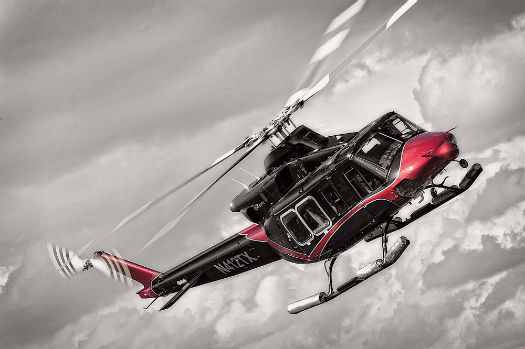
Vertical contributing editor Guy Maher conducts a flight assessment of the BLR Aerospace FastFin on a Bell 412EPI. Mike Reyno Photo
The process of taking an aircraft from conception through to marketing the final product is pretty much standard. A manufacturer either knows or perceives that a market need exists, and looks to provide the most cost-effective aircraft solution to meet that need.
And once an aircraft has been fielded and operators have used it for a while, it’s pretty much guaranteed that they’ll soon demand more from the type than it was originally designed for. Or, in some cases, they may just seek ways to achieve the performance promised by the original equipment manufacturer (OEM), or to improve certain flight qualities.
While OEMs can elect to modify the existing design or bring to market an entirely new one, many operators are not willing or able to replace their huge investment in their current aircraft with new variants just to gain specific improvements — especially when the aircraft normally does a decent job.
This is why the business of aircraft modifications and accessories is so robust. And one of the key players in improving the performance and handling of existing aircraft — for both fixed-wing and rotorcraft — is BLR Aerospace.
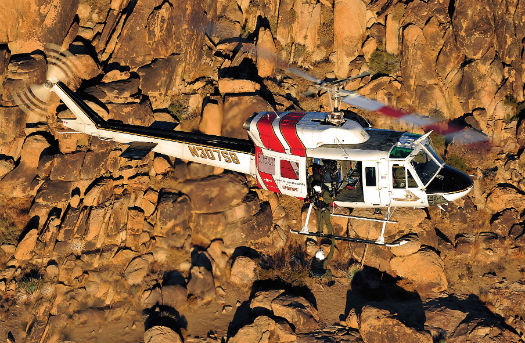
Hovering out of ground effect, especially in hot, high, and/or “off wind” conditions, are where the benefits of the FastFin really stand out. Skip Robinson Photo
In the rotorcraft world, BLR is noted for expanding aerodynamic capabilities through its FastFin system, which modifies the vertical fin and adds strakes along the tail boom. But the genesis for the benefits FastFin operators receive today goes back to 1991 and the founding of a company called Boundary Layer Research (which would later be renamed BLR Aerospace) by Bob Desroche, an individual with a natural affinity for, and understanding of, aerodynamics.
Desroche, who had a fixed-wing background, began his research by looking at improving the handling qualities of the twin-engine, turbocharged, pressurized Beechcraft Duke. He started with strakes, mounted under the aft tail section, to improve the aircraft’s yaw characteristics — and he received his first supplemental type certificate (STC) for the type in 1992.
This eventually led to a full line of products developed to improve the handling, range, and performance of the Duke, such as winglets, wet fuel tanks, and vortex generators. The package has become so popular that in the past 20 years, 70 percent of the worldwide Duke fleet has undergone the BLR treatment.
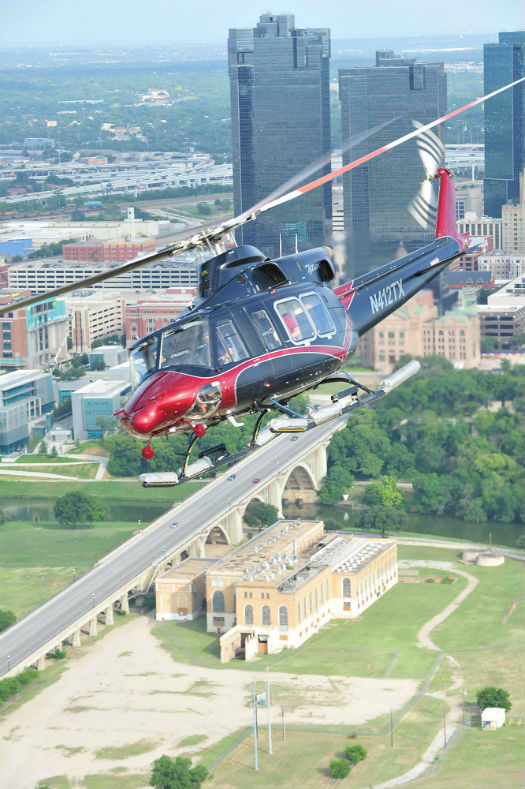
The Bell 412 can realize a substantial increase in useful load at higher altitudes, while having a much larger wind limits envelope in which to operate. Mike Reyno Photo
Moving into new markets
During the design and development of the Duke modifications, Desroche became aware of NASA engineer Henry Kelly’s work on the benefits of installing strakes on the tail booms of helicopters. Desroche consulted with some rotorcraft-savvy people and ultimately concluded that the strakes were of value and could be marketed.
As a result, Desroche negotiated the exclusive right with NASA to use their patent on the strakes. In 2003/4, he invested in tufting, computational fluid dynamic, wind tunnel, and flight testing, so as to optimize the tail boom strake hardware for his first subject — the Bell UH-1H. The benefit to the performance and handling of the helicopter was palpable, and the strakes soon found their way onto additional airframes such as the Bell 204/205 series, as well as the Bell 212 and 412.
Although BLR calls them “strakes,” they really don’t act like the conventional strakes on airplanes such as the Duke, which serve as an extra tail fin(s) to improve yaw stability — or multiple axes to counter the tendency of certain airframes to “Dutch roll” in specific flight regimes.
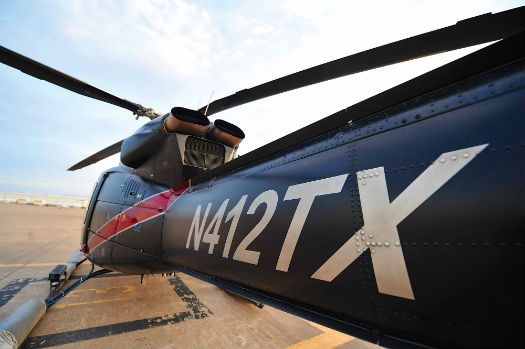
On conventional helicopters, the BLR strakes can be found on the left side of the tail boom, which reduces left pedal demand. Mike Reyno Photo

By opening up a notch in the vertical tail fin, the FastFin modification reduces blocking of the tail rotor thrust. Mike Reyno Photo
In helicopter applications, strakes are more akin to stall strips on fixed-wing aircraft. When an aircraft stalls, with certain designs, the entire wing from root to tip can stall at the same time. So, not only does the core wing quit flying, but the ailerons’ ability to affect roll control goes away at the same time. One of the ways designers combat this is to place small triangular strips of about a foot long on the leading edge of the inboard section of the wing. This way, when the wing reaches its critical angle of attack, the strips break up the airflow — thus disrupting the smooth low pressure area — over the inboard section of the wing first. This in turn allows the outboard section of the wing to remain flying a little longer and provides roll authority during the stall onset and recovery.
In a conventional helicopter, such as the Bell 412, the main rotor airflow during a hover comes down vertically over the tail boom from right to left (from the perspective of looking forward from the tail boom). Accordingly, the tail boom actually acts like a wing which produces “lift” in the same — and unwanted — direction as the main rotor torque. The BLR strakes act as stall strips would on a fixed-wing — breaking up the airflow on the low pressure of the “wing,” which is the tail boom, and destroying the undesired “lift” to the left, thus reducing the demand for left anti-torque pedal.
There are two strakes that come with the modification. The upper strake acts like the stall strip described above. The lower strake actually organizes the residual airflow and deflects it left away from the right hand flow of the boom. Besides the obvious benefit of reducing the left pedal demand, this also adds stability by reducing the occurrence of left-right pedal reversals as well as helping to reduce component wear.

While BLR is well known for producing its performance enhancing technologies for Bell helicopters, it is looking at other aircraft that could benefit from its technologies, including the Airbus Helicopters AS350 AStar. Mike Reyno Photo
But BLR didn’t stop with the tail boom strakes. In late 2004, design work began on a vertical fin modification, which would become the second element of the FastFin system. The company determined that the surface area of the fin could be relocated to a point lower and more aft of the conventional tail boom. By doing this, a notch can be cut out of the aft area of the vertical fin that blocks a good portion of the major thrust generated by the tail rotor.
Additionally, the modified tail fin is rounded on the aft section and provides a very smooth trailing edge. The large radius curve is actually the same as the tail fin leading edge. This makes it easier to manage the flow over the fin without “tripping” or disturbing it — especially during “off-wind” maneuvers. And although tail rotor authority is increased, by maintaining the same — but relocated — tail fin surface area, the helicopter keeps its original handling qualities for maneuvers such as run-on landings.
The FastFin gained its first STC for the UH-1 (in early 2005), and this was then joined by STCs for the 204/205s, 212, and finally the 412 (in 2010). In 2011, BLR started a formal relationship with Bell, and the FastFin became a post certification STC modification. The following year, Bell began incorporating the FastFin within the type certificate of the 412EP through a licensing agreement with BLR, and it now comes standard on all new 412EP and EPI helicopters.
Flying the FastFin
My opportunity to experience the full FastFin treatment came this past summer when I was invited to fly the Bell 412EPI. With 18 years of line flying experience with the 412, I was understandably excited to try out the latest variant.
It was a typical hot and humid afternoon in the Dallas, Texas, area for my flight. Loaded to within eight percent of the 412’s 11,900-pound maximum gross weight, the takeoff quickly made me feel right at home. I performed a vertical takeoff, pulling 97 percent torque, which generated a rate of climb of 1,500 feet per minute. What the straight up climb didn’t generate was near as much left pedal deflection as I would have experienced doing the same maneuver in a non-FastFin equipped 412.
At 2,000 feet above sea level, my first test was hovering out of ground effect. I positioned into the wind, which was 14 knots at altitude, and confirmed being stationary over a landmark. Hover left pedal displacement was noticeably less than I was used to in my 412 flying. Then I began a left pedal turn, and I clearly expended less pedal displacement during the turn from the standard 412.
As I passed into the downwind condition and continued on, the turn remained very stable and smooth. There was no tendency for the tail to want to whip or buck with pedal reversals. The turn was rock solid.
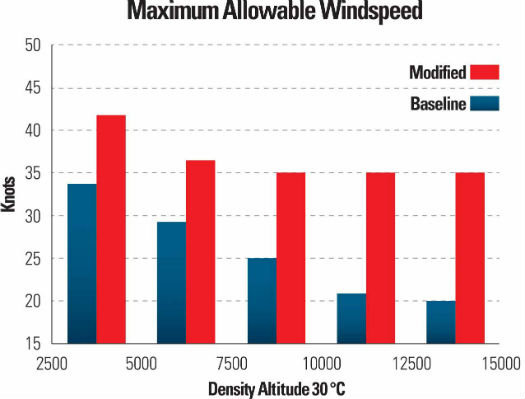

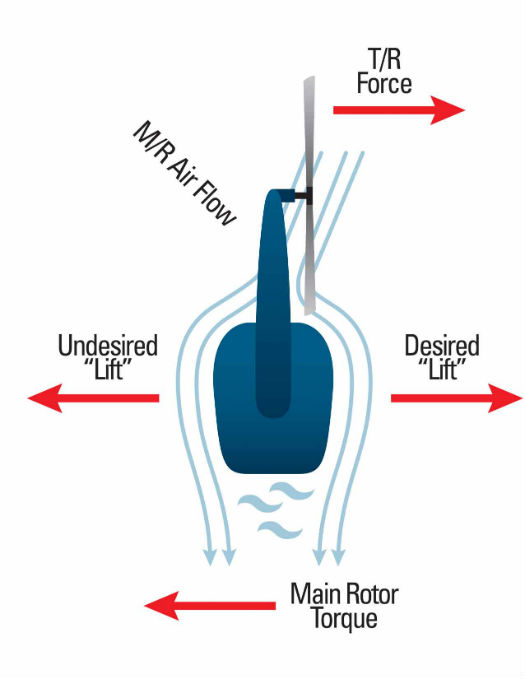
I had heard the claims of an increased hover in ground effect useful load benefit for the FastFin-equipped 412 of up to 1,250 pounds — a 91 percent increase — even though the max gross weight remains the same. Now it made sense. The positive change to the weight/altitude/temperature (WAT) chart, combined with increased wind azimuth tolerance, means that even though altitude and/or temperature may rise, the lower power demand from the tail rotor, combined with higher wind limits, allows more weight to be carried at those higher altitudes.
And speaking of wind, the critical wind azimuth for the FastFin 412 gained a full 10 knots at sea level to 45 knots. This delta remains roughly the same until about 7,500 feet, where the FastFin limit stops at 35 knots — whereas the stock 412 limit continues to drop down to 20 knots.
The one exception is that for the FastFin equipped 412, the higher wind limit is reduced to 30 knots when it’s a tail wind from 30 degrees left, to 30 right of the tail. However, this is not a controllability issue — it’s due to exhaust gas circulation and its effect on engine cooling.
Back at the airport, I wanted to try some sideways flying. Cleared for maneuvering, I turned perpendicular to the taxiway and put in some right cyclic. I was aiming for around 35 knots. I looked down at the GPS display — and sure enough, it was at 37 knots. However, as I was going sideways into an eight knot wind directly from my right, I was, in essence, flying at 45 knots — and the ride and handling couldn’t have been more solid.

The FastFin-equipped helicopter retains all the normal handling characteristics of the stock vertical fin by shifting the surface area below and aft. Shawn Evans Photo
After repositioning, I did the same thing but with the wind directly off my left — this time indicating 12 knots on the automated surface observation system. The GPS showed 32 knots over the ground into a 12 knot wind. Full, 360-degree pedal turns, regardless of wind position, were smooth and consistent, with not even a hint of the tail wanting to get loose — or “weather-cocking.”
To me, crosswind operations are really where the FastFin shines the most on the 412. And pilots of stock 412s (or the other approved models) who switch to those equipped with the FastFin system will definitely be rethinking their operational limits to take advantage of the increased performance and handling.
Next in Line
According Dave Marone, BLR’s vice president of sales and marketing, there are about 700 helicopters around the world utilizing the FastFin system, and about 5,000 aircraft in total that are using performance-enhancing STCs from the company. He said BLR continues to develop new technologies for new fixed- and rotary-wing aircraft types.
“We have recently flown the Bell 407, the AH-1 Cobra, the [Sikorsky] S-61 and will soon fly the [Airbus Helicopters] AS350 B3e,” said Marone. “And it’s safe to say that these airframes, which either have the need or could take advantage of our products, will be next in line.”

The Bell UH-1/204/205 series helicopters were the first to receive the FastFin treatment. Andy Martin Photo
Additionally, Marone hinted at three new technologies that BLR is working on — aimed at meeting the ever-demanding challenge of providing more useful load without making any major structural modifications to an airframe. “As new technologies come to being, we will continue a pattern of pushing up the base line performance of certificated aircraft,” he said.
When you have an aircraft that needs some help — such as more useful load, or more left pedal — one solution is more power. Of course, that means a bigger tail rotor, tail rotor gearbox, and drive system. It can — and has — been done. Consider the Bell history from the UH-1 through the 204/205/212/214/412 series. Then consider the cost for the OEM in development and certification, which is passed on to the operator to purchase and operate the new design.
Now consider a system with the performance potential to reclaim 10 percent of the lost tail rotor effectiveness, boost the base line WAT limits, and allow more useful load where it’s needed most. I realize that potential is certainly interesting, but performance is absolutely everything.
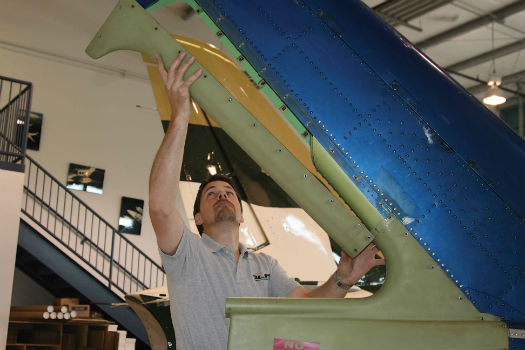
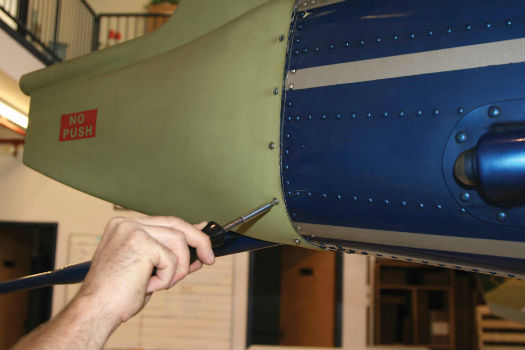
There are about 700 helicopters around the world that have been fitted with a FastFin. Bell began incorporating the FastFin within the type certificate of the 412EP through a licensing agreement with BLR in 2012, and it now comes standard on all new 412EP and EPI helicopters. BLR Photos
It was clear to me after flying the FastFin system that more value was certainly added to the airframe. And this was done without the OEM — and ultimately the aircraft owner — having to absorb the cost of a new platform. With the cost of operations skyrocketing, anything that helps lower those costs while increasing utility will be a surefire winner. It’s safe to say BLR Aerospace can plan on keeping mighty busy.
Guy R. Maher is a 16,000+ hour dual-rated pilot and flight instructor for helicopter, airplane and instrument ratings. Retired after 24 years as an HEMS pilot, he continues to run his aviation services company – Lanier Media – established in 1978. In addition to being a FAASTeam representative, Guy is frequently called upon to provide consultation on aircraft sales, operational, and safety issues, and litigation support. He can be contacted at guy@www.verticalmag.com.





